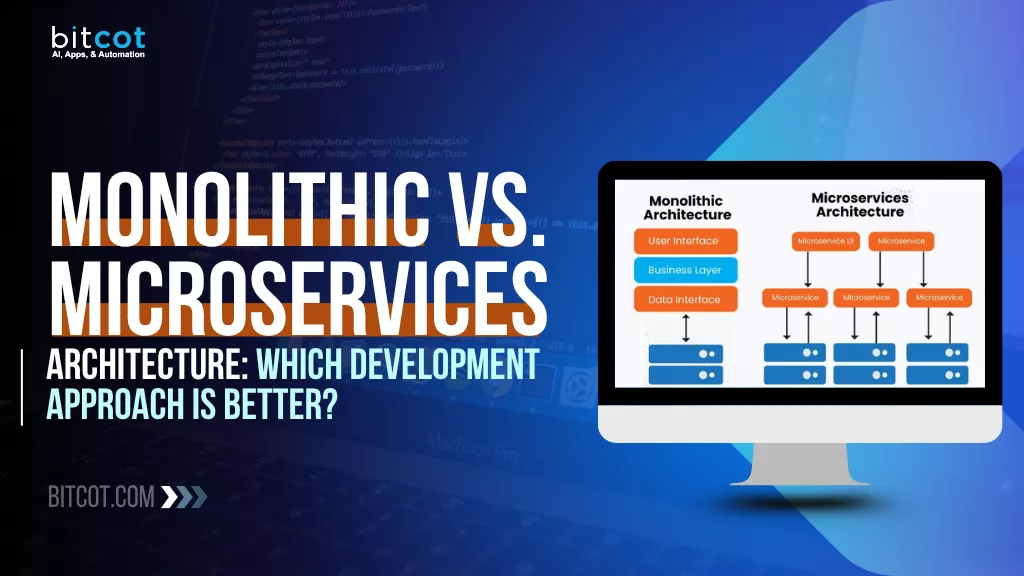
Your application architecture is the foundation of everything you’ll build.
The decisions you make today about how your system is structured will impact your team’s productivity, your product’s scalability, and your ability to respond to market changes for years to come.
So here’s the critical question: do you build a single, unified application with a monolithic architecture, or do you break everything into independent microservices that can scale and evolve separately?
Both approaches can power successful products, but they come with fundamentally different trade-offs in complexity, speed, and long-term flexibility.
Sound familiar?
Every technical leader, CTO, and product manager eventually faces this architectural crossroads.
In 2026, with cloud-native infrastructure, containerization, and AI-driven development tools reshaping how we build software, choosing the right architecture has never been more strategic or more impactful.
In this post, we’ll break down the real-world advantages and challenges of monolithic vs. microservices architecture, so you can make an informed decision that aligns with your team’s capabilities, your product’s requirements, and your business goals.
Ask yourself:
- Is simplicity more important than scalability right now?
- Do you have the team expertise to manage distributed systems?
- How quickly does your product need to evolve and scale?
Whether you’re a startup founder launching your first product, a growing company hitting scaling challenges, or an enterprise software architect planning your next-generation platform, this architectural decision will shape your product’s future.
At Bitcot, we help businesses architect and build scalable software systems every day, choosing the right approach based on real-world needs, not just architectural trends.
The future of software architecture is about making smart choices that balance innovation, maintainability, and business value. Are you ready to choose the architecture that sets your product up for success?
What Are Monolithic and Microservices Architectures?
When you’re planning to build a new application or platform, one of the most fundamental decisions you’ll make is how to structure your system’s architecture. Should you build everything as one unified application, or should you break it into smaller, independent services?
Both architectural patterns have proven themselves in production environments across thousands of companies, and understanding their core differences can help you make the right choice for your specific situation.
Monolithic architecture means building your entire application as a single, unified codebase. All components, features, modules, and business logic live together in one application that’s deployed as a single unit. This approach provides simplicity, straightforward development workflows, and easier initial deployment.
However, it can create challenges as your application grows, making updates riskier and scaling more complex.
Microservices architecture, on the other hand, involves breaking your application into multiple small, independent services that each handle a specific business capability. Each service runs in its own process, has its own database, and communicates with other services through well-defined APIs.
Microservices offer flexibility, independent scalability, and technology diversity. The trade-off is increased operational complexity and the need for sophisticated DevOps practices and distributed system expertise.
In essence, monolithic architecture gives you simplicity and cohesion, while microservices architecture gives you flexibility and scalability. The best choice depends on your team’s experience, your product’s maturity, and your growth trajectory.
| Aspect | Monolithic Architecture | Microservices Architecture |
| Definition | Single unified application with all components in one codebase. | Multiple independent services, each handling specific functionality. |
| Deployment | The entire application is deployed as one unit. | Each service is deployed independently. |
| Scalability | Scale the entire application, even if only one feature needs more resources. | Scale individual services based on specific demand. |
| Development Speed | Faster initial development and easier to understand. | Slower initial setup but faster feature development once established. |
| Technology Stack | Single technology stack across the entire application. | Each service can use different technologies best suited for its purpose. |
| Team Structure | Works well with smaller, centralized teams. | Better for larger, distributed teams organized around services. |
| Testing | Simpler end-to-end testing in one environment. | More complex integration testing across services. |
| Failure Impact | One bug can bring down the entire application. | Failures are isolated to individual services, limiting overall impact. |
| Operational Complexity | Lower; easier to deploy, monitor, and manage. | Higher; requires sophisticated DevOps, monitoring, and orchestration. |
Key Features of Monolithic and Microservices Architectures
Understanding what makes each architectural approach unique can really help you determine which pattern fits your product vision, team capabilities, and business requirements. Each architecture comes with its own characteristics that can either accelerate or complicate your development journey.
In the next section, we’ll explore the defining features of both monolithic and microservices architectures so you can see which approach aligns best with your technical needs and organizational maturity.
Key Features of Monolithic Architecture
Monolithic architecture refers to building your entire application as a single, self-contained unit where all components, business logic, and data access layers exist within one codebase and runtime process.
This approach is favored by startups, small teams, and businesses prioritizing speed to market and simplicity over distributed complexity.
1. Single Codebase
All application code lives in one repository, making it easier for developers to understand the full system, navigate between components, and maintain consistency across features.
2. Unified Deployment
The entire application is built, tested, and deployed as one package. This simplifies the deployment process and reduces the need for complex orchestration tools.
3. Simplified Development Environment
Developers can run the entire application locally with minimal setup, making onboarding faster and debugging more straightforward.
4. Strong Data Consistency
Since everything uses a single database, maintaining data integrity and implementing transactions across features is simpler and more reliable.
5. Straightforward Testing
End-to-end testing happens within one application context, eliminating the complexity of testing distributed systems and service interactions.
6. Lower Operational Overhead
With one application to monitor, log, and maintain, operational complexity remains manageable without specialized DevOps tooling.
7. Tight Component Integration
Since all components exist in the same process, communication between modules is fast and doesn’t require network calls or API contracts.
Key Features of Microservices Architecture
Microservices architecture involves decomposing your application into multiple independent services, each responsible for a specific business capability and capable of being developed, deployed, and scaled independently.
This model is ideal for organizations managing complex systems, requiring high scalability, and having mature DevOps practices.
1. Independent Services
Each microservice handles a single business function and can be developed, tested, and deployed without affecting other services.
2. Technology Flexibility
Different services can use different programming languages, frameworks, and databases, allowing teams to choose the best tool for each specific task.
3. Independent Scalability
Scale only the services experiencing high load rather than scaling the entire application, optimizing resource usage, and reducing infrastructure costs.
4. Fault Isolation
If one service fails, others continue running, preventing a single point of failure from bringing down your entire system.
5. Decentralized Data Management
Each service manages its own database, giving teams full control over their data model and technology choices.
6. Continuous Deployment
Teams can deploy updates to individual services without coordinating releases across the entire system, enabling faster iteration.
7. Organizational Alignment
Microservices support autonomous teams that own specific services, allowing for parallel development and clearer ownership.
Also Read: Why Serverless Architecture Is the Money-Saving Business Solution That Scales Fast
Pros and Cons of Monolithic and Microservices Architectures
Choosing between monolithic and microservices architecture is one of those decisions that can fundamentally shape your product’s technical future. Both patterns have real strengths and real challenges, and understanding them helps you avoid costly architectural mistakes.
To help you think through this choice more clearly, let’s look at the advantages and disadvantages of each approach so you can match your architecture to your actual business needs and team capabilities.
Monolithic Architecture: Simplicity and Speed
Monolithic architecture means building your application as one cohesive unit. This approach works especially well for early-stage products, small teams, and applications where simplicity and speed matter more than distributed scalability.
Pros of Monolithic Architecture
- Faster Initial Development: Simple structure means developers can build features quickly without worrying about service boundaries or inter-service communication.
- Easier to Understand: New developers can grasp the entire system more quickly since everything exists in one codebase.
- Simplified Deployment: Deploy the entire application in one step without orchestrating multiple services or managing dependencies between them.
- Straightforward Testing: Test the full application in one environment without dealing with distributed system complexity or service mocking.
- Lower Infrastructure Costs: Run everything on fewer servers with less operational overhead and simpler monitoring requirements.
Cons of Monolithic Architecture
- Scaling Limitations: Must scale the entire application even when only one feature experiences high load.
- Slower Build and Deploy Times: As the codebase grows, building, testing, and deploying become increasingly time-consuming.
- Limited Technology Choices: Stuck with one technology stack across all features, making it harder to adopt new technologies.
- Risky Deployments: Any update requires redeploying the entire application, increasing the risk of system-wide failures.
- Team Coordination Challenges: Large teams working in the same codebase can experience merge conflicts and coordination overhead.
Microservices Architecture: Flexibility and Scalability
Microservices architecture involves breaking your application into independent services that communicate through APIs. This approach suits mature products, larger teams, and organizations that need flexibility and independent scalability.
Pros of Microservices Architecture
- Independent Scalability: Scale specific services based on actual demand rather than scaling everything uniformly.
- Technology Flexibility: Choose the best technology for each service without being constrained by a single stack.
- Faster Feature Development: Teams can work on different services simultaneously without stepping on each other’s toes.
- Fault Isolation: Service failures don’t cascade across the entire system, improving overall reliability.
- Easier Team Autonomy: Smaller services enable independent teams to own and evolve their domains without constant coordination.
Cons of Microservices Architecture
- Increased Complexity: Managing multiple services, databases, and deployment pipelines requires sophisticated tooling and expertise.
- Operational Overhead: Monitoring, logging, and debugging across distributed services demands mature DevOps practices.
- Network Latency: Service-to-service communication introduces latency and potential points of failure.
- Data Consistency Challenges: Maintaining consistency across multiple databases requires careful design and eventual consistency patterns.
- Higher Infrastructure Costs: Running multiple services independently often requires more servers, containers, and supporting infrastructure.
Both monolithic and microservices architectures can deliver successful products when properly aligned with your business context. The key is honestly assessing your team’s capabilities, your product’s maturity, and your scaling requirements, then choosing the architecture that supports your immediate needs while enabling future growth.
Monolithic vs. Microservices Architecture: Key Differences & Comparison
When you’re deciding how to architect your application, understanding the practical differences between monolithic and microservices approaches is essential.
Each pattern creates different development experiences, operational requirements, and business outcomes.
Below is a detailed comparison of the key differences between monolithic and microservices architecture, helping you identify which approach matches your product’s stage, team structure, and growth plans.
1. Development Speed and Complexity
Monolithic Architecture: Initial development is faster because developers work in a familiar, unified codebase without worrying about service boundaries, API contracts, or distributed system patterns. New features can be added directly without coordinating across multiple services.
Microservices Architecture: Initial setup is slower due to the need to define service boundaries, establish communication patterns, and set up infrastructure. However, once established, teams can develop features in parallel across different services, potentially increasing overall velocity.
Verdict: Monolithic wins for speed to market and early-stage products, while microservices excel once your team and product reach a certain maturity level.
2. Scalability and Performance
Monolithic Architecture: You must scale the entire application even if only one feature experiences high traffic. This can lead to inefficient resource usage and higher infrastructure costs as your application grows.
Microservices Architecture: Individual services can be scaled independently based on actual demand. If your payment service needs more capacity, you can scale just that service without touching others.
Verdict: Microservices provide superior scalability for applications with varying load patterns, while monoliths work fine for applications with uniform scaling needs.
3. Team Structure and Organization
Monolithic Architecture: Works best with smaller, centralized teams where developers need visibility across the entire application. Everyone works in the same codebase, which can create coordination challenges as teams grow.
Microservices Architecture: Enables autonomous teams that own specific services end-to-end. Teams can make decisions independently, choose their own tools, and move at their own pace.
Verdict: Monolithic architecture suits smaller teams, while microservices align better with larger organizations and distributed teams.
4. Deployment and Release Process
Monolithic Architecture: The entire application must be redeployed even for small changes. This creates longer deployment cycles and higher risk, as any bug can affect the entire system.
Microservices Architecture: Services can be deployed independently, enabling continuous deployment and reducing risk. Teams can release updates without coordinating with other teams or waiting for deployment windows.
Verdict: Microservices enable faster, safer deployments, while monoliths require more careful release coordination.
5. Technology Stack and Flexibility
Monolithic Architecture: Your entire application uses one technology stack. While this promotes consistency and easier knowledge sharing, it limits your ability to adopt new technologies or use specialized tools for specific problems.
Microservices Architecture: Each service can use different languages, frameworks, and databases based on what works best for that specific functionality. This flexibility comes at the cost of increased complexity and a learning curve.
Verdict: Microservices win for technology diversity, while monoliths provide consistency and simplicity.
6. Operational Complexity
Monolithic Architecture: Simpler to operate, monitor, and debug. You have one application to deploy, one set of logs to review, and one process to monitor.
Microservices Architecture: Requires sophisticated DevOps practices, distributed tracing, service mesh, container orchestration, and advanced monitoring tools. The operational burden increases significantly.
Verdict: Monolithic architecture has much lower operational overhead, while microservices demand mature DevOps capabilities.
| Aspect | Monolithic Architecture | Microservices Architecture |
| Development Speed | Faster initially | Slower initially, faster at scale |
| Scalability | Scale the entire application | Scale individual services |
| Team Structure | Smaller, centralized teams | Autonomous, distributed teams |
| Deployment | Single, coordinated deployment | Independent service deployments |
| Technology Flexibility | One stack for everything | Different stack per service |
| Operational Complexity | Lower; simpler to manage | Higher; requires advanced DevOps |
| Fault Tolerance | Single point of failure | Isolated service failures |
| Best For | Early-stage products, small teams | Mature products, large organizations |
Final Verdict: Which Architecture Is Best for Your Application?
Choosing between monolithic and microservices architecture isn’t really about finding the “better” option; it’s about finding the one that fits your application best. Your product stage, your team capabilities, and the kind of system you’re building all play a big role in that decision.
Each approach brings its own strengths to the table, and the right choice often depends on where your product is today, how fast you need to move, and how much complexity your team can realistically handle.
How to Choose the Right Architecture
Before deciding, consider the following key factors:
1. Product Maturity and Stage
- For new products, MVPs, or unproven ideas, monolithic architecture offers faster development and simpler validation.
- For mature products with established market fit and clear growth patterns, microservices provide the scalability and flexibility needed for evolution.
2. Team Size and Experience
- Monolithic architecture suits smaller teams (under 10-15 developers) or teams without distributed systems expertise.
- Microservices work best with larger teams (20+ developers) who have experience with containers, orchestration, and DevOps practices.
3. Scaling Requirements and Patterns
- If your application scales uniformly, a monolith is often more efficient and cost-effective.
- If different features have drastically different scaling needs, microservices allow you to optimize resource usage.
4. Deployment Frequency and Risk Tolerance
- For weekly or monthly releases, monolithic deployment simplicity is an advantage.
- For continuous deployment with multiple daily releases, microservices enable safer, independent updates.
5. Operational Capabilities
- Monolithic architecture requires basic DevOps skills and minimal infrastructure.
- Microservices demand mature operational practices, sophisticated monitoring, and infrastructure automation.
When to Use Monolithic Architecture
Use monolithic when:
- You’re building a new product and need to validate your idea quickly.
- Your team is small and focused on speed to market.
- You want to minimize infrastructure costs and operational complexity.
- Your application doesn’t have drastically different scaling requirements across features.
- You lack experienced DevOps engineers or distributed systems expertise.
Avoid monolithic when:
- You’re experiencing significant scaling bottlenecks that affect the entire application.
- You have multiple teams that need to work independently.
- Your deployment process has become too risky or time-consuming.
- Different components require fundamentally different technology stacks.
When to Use Microservices Architecture
Use microservices when:
- You have a proven product with clear domain boundaries and business capabilities.
- Your team is large enough to support multiple independent services.
- Different parts of your system have significantly different scaling requirements.
- You need frequent, independent deployments without coordination overhead.
- You have strong DevOps capabilities and infrastructure automation in place.
- Technology flexibility is important for different services.
Avoid microservices when:
- You’re building an MVP or haven’t validated product-market fit.
- Your team lacks distributed systems experience.
- You don’t have mature monitoring, logging, and debugging infrastructure.
- Your budget is limited, and you need to control infrastructure costs.
- Your organization isn’t prepared for operational complexity.
There’s no universal answer to which architecture is best; the right choice depends on your application’s requirements, your team’s capabilities, and your business priorities.
The key is to evaluate your specific situation honestly, define what success looks like for your product, and select the architectural approach that aligns with both your current needs and your realistic growth trajectory. Making the right decision now can significantly impact your development velocity, system reliability, and long-term competitiveness.
Partner with Bitcot to Build Your Software Architecture
If you’re ready to build a software system that actually matches your business needs and sets you up for sustainable growth, partnering with Bitcot is a smart place to start.
We’re not just another development shop; we’re a team that understands architecture isn’t about following trends; it’s about building systems that work for your specific situation, your team, and your goals.
Whether you’re launching a new product, refactoring an existing system, or planning your next growth phase, Bitcot has the architectural expertise and development experience to help you make the right choices and execute them well.
Why partner with Bitcot:
- Architectural Expertise: Our team has designed and built both monolithic and microservices systems across industries, giving us the real-world experience to guide your architectural decisions.
- Pragmatic Approach: We recommend what actually fits your situation, not what’s trendy. If a monolith serves you better, we’ll tell you. If microservices make sense, we’ll explain why.
- Full-Stack Capabilities: From system design and backend development to APIs, databases, and cloud infrastructure, we handle every layer of your architecture.
- DevOps Maturity: We bring the DevOps expertise needed to operate modern architectures, including containerization, orchestration, monitoring, and CI/CD pipelines.
- Scalable Solutions: We build systems that can evolve with your business, whether that means refactoring a monolith, extracting microservices, or optimizing existing architectures.
- Technology Flexibility: We work with modern tech stacks and cloud platforms, choosing the right tools for your specific requirements rather than forcing one-size-fits-all solutions.
- End-to-End Support: From initial architecture design through development, deployment, and ongoing optimization, Bitcot provides complete lifecycle support for your system.
Partnering with Bitcot means working with a team that understands architecture is a means to an end, building software that serves your business goals efficiently, reliably, and sustainably.
Final Thoughts
Choosing between monolithic and microservices architecture doesn’t have to be overwhelming, and honestly, there’s no universal “right answer.” Every product, every team, and every business is different.
If you’re in the early stages, building an MVP, or working with a small team, a monolithic architecture is probably your best bet. It’ll help you move faster, keep things simple, and focus on validating your product without getting bogged down in infrastructure complexity.
But if you’re managing a mature product with proven market fit, experiencing scaling challenges, and have the team expertise to handle distributed systems, then microservices can give you the flexibility and scalability you need to grow efficiently.
And if you’re not quite sure yet, that’s completely normal. Many successful companies start monolithic and evolve toward microservices as their needs change. The key is being intentional about your choice and building in a way that lets you adapt as you grow.
The most important thing is choosing an architecture that matches where you are right now, not where you hope to be someday or where other companies are.
At the end of the day, whether you’re building a monolith or microservices, having the right architectural partner makes all the difference.
If you’re ready to build a system that’s designed for your actual needs and positioned for real growth, Bitcot is here to help. Our team specializes in custom software development services that bring your vision to life with the right architecture, the right technology, and the care your product deserves.
Let’s build something that actually works for your business. Get in touch to start your development journey with a partner who understands architecture, strategy, and execution.












